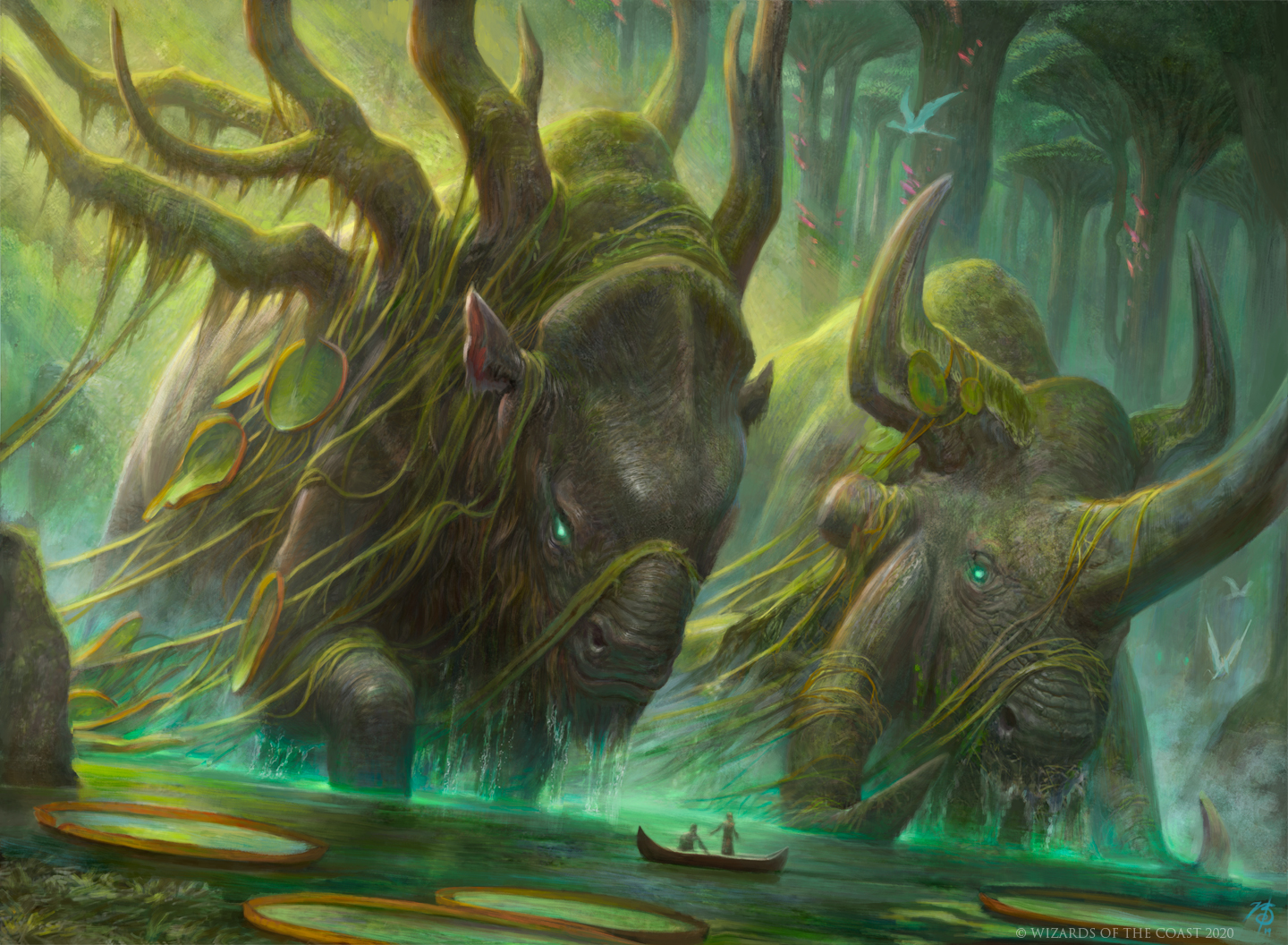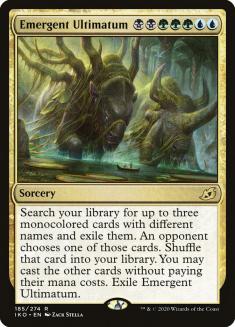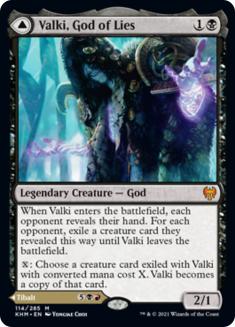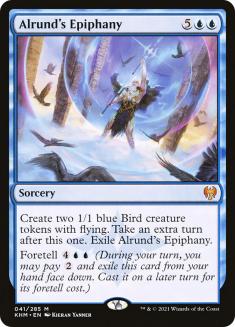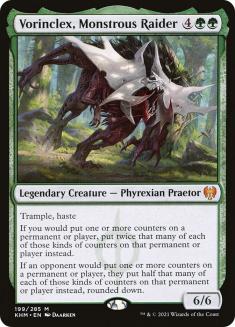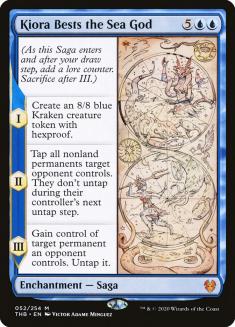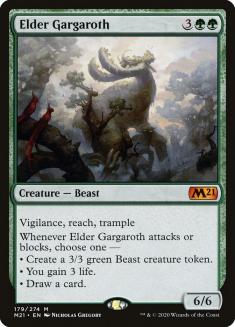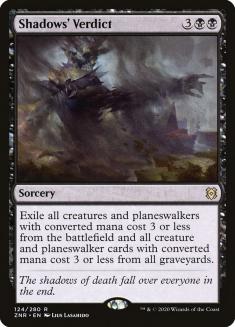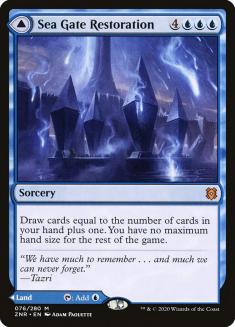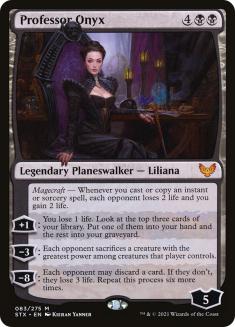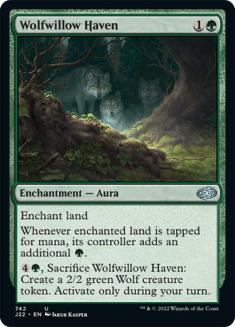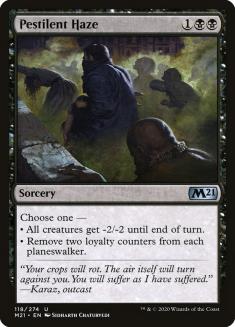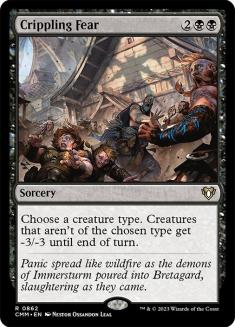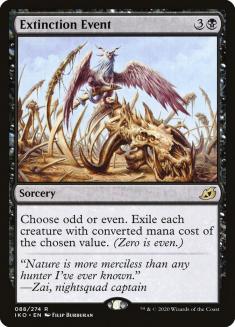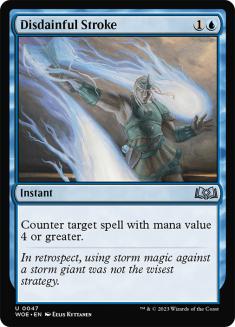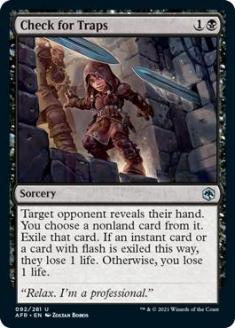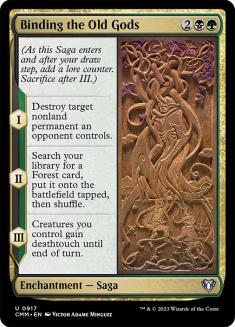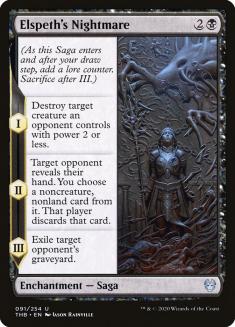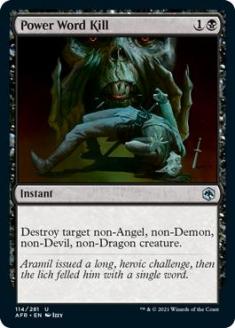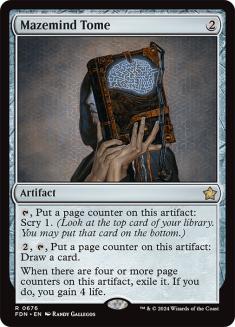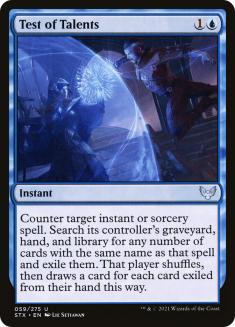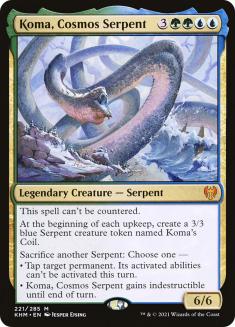For a long time, Sultai Ramp (Yorion) was considered by many (including myself) the best deck in Standard. Then, with the advent of Adventures in the Forgotten Realms (AFR), things changed. All of a sudden, every aggro deck got a creature-land, and red decks could more easily remove Elder Gargaroth. The deck lost its “best deck” status and for a while became an unpopular choice – at the Challenger Gauntlet, for example, only one of the competitors chose to submit Sultai Ramp (Yorion). Fast forward to a week later, however, and it seems like the rumors of Sultai’s demise have been greatly exaggerated:
Does this mean Sultai Ramp is back to being the best deck? No, not really. We’re in a very balanced metagame now, and I don’t think there’s a true best deck (though, if there is, that deck is Naya Winota). Nevertheless, I strongly believe Sultai Ramp is still one of the best decks, and it’s still my personal pick for best deck in AFR Standard, even though that can be highly metagame-dependent. I’ve played the deck a lot, and in this article I will tell you all about it.
This is my current list:
Creatures (8)
Lands (32)
Spells (40)

Sultai Ramp (Yorion) is a hybrid control-combo deck. It can win by controlling the game and eventually killing you, and it can win by assembling its combo. The main difference between this deck and previous control-combo decks is that the “combo” is Emergent Ultimatum and seven lands of the right colors — no other card necessary. If you build your deck well, Emergent Ultimatum lets you go over the top of everyone else. This gives you a big advantage over most decks that are too slow to kill you before you get there; all you need to do is survive until you hit seven mana and find your win condition. Sultai Ramp (Yorion) is well-equipped for that.
Even though Sultai Ramp (Yorion) has several bad matchups, those bad matchups are all very close. You can even turn them into good matchups if you have the right build. I believe Mono-White Aggro❄, Mono-Red Aggro❄, and Dimir Rogues are all bad matchups, but they are only slightly bad. Your good matchups, on the other hand, are very good. Naya Adventures, for example, which has been gaining in popularity now, is very favorable; there’s no matchup that is as bad as Naya Adventures is good. If you face half good matchups and half bad matchups in a tournament, you’ll have a better than 50% record.
There are still metagames in which it’s wrong to play Sultai Ramp, and it’s a control deck, which means you can misbuild it if you don’t predict the field correctly (this is always the case when you can choose to play either Negate or Heartless Act in your deck), but I think right now is actually a good spot to be in. Most other decks are creature-based, which means your deck won’t often mismatch against the opposition, and everyone else will be tuning their decks to beat creatures, which makes it easier for you to win. For example, you’ll choose to play Heartless Act instead of Negate, and that’ll almost always be right; everyone else will choose Heartless Act instead of Negate (or whatever the equivalent for their archetype is), which will be worse against you.
In sum, I think Sultai Ramp is definitely a Tier 1 deck right now. It’s the deck I would play if I had a tournament coming up. It’s become less powerful than it was before (since everyone else’s deck got better), so that’s definitely a bad thing, but it also happens to be well-positioned in the current creature-centric metagame, which evens things out a bit. While not leaps and bounds better than everything by any means (and in fact I don’t know if it’s in first, second, or third), it’s totally viable if you want to play it.
That said, here’s how you do play it:
The Ultimatum
Emergent Ultimatum is your most important card, and casting it will win you the game almost every time. There are three main situations it doesn’t happen:
- You’re very low on life and they have lethal reach. There’s no immediate lifegain in the deck (you can get Elder Gargaroth and Alrund’s Epiphany, but they don’t have to give you these two cards), which means sometimes you’re low enough that you die anyway. If you’re on two life and the top card of their deck is Bonecrusher Giant, you can’t avoid dying there.
- You’re playing against another control deck and they manage to answer all your Ultimatum threats.
- You’re facing Dimir Rogues and you cast Ultimatum late enough that they’ve already milled most of your important cards.
These situations are few and far between. I played two MPL League Weekends and a Championship, and in all these tournaments combined, I believe I only lost one game where I successfully cast Emergent Ultimatum (a game in which I cast two, no less). I might be misremembering and forgetting an occasion, but even if I am, it’s definitely a rare occurrence.
Ultimatum Piles
Which Ultimatum pile you get will depend on the state of the battlefield, what’s left in your deck, whether you’re sideboarded or not, etc. Here are the most common ones:
This is the most common Ultimatum pile into an empty battlefield. Most of the time people will give you Alrund’s Epiphany + Vorinclex, which is fourteen damage and an extra turn. With any other creature on the battlefield, that’s a lethal combination, so your opponent cannot give you these two cards. Instead you’re left with a Tibalt, Cosmic Impostor that can ultimate immediately (because you select Vorinclex last, which means it enters the battlefield first and will double the Tibalt counters) or, more likely, a Tibalt and an extra turn.
This is the anti-aggro version of the previous pile. You get the same fourteen damage and a turn, but this is better if graveyards aren’t stacked and Tibalt’s ultimate is weak. If they give you Kiora Bests the Sea God and any of the other two cards, then Chapter 2 of the Saga will trigger before they have a chance to untap (since Vorinclex will add two counters to it and Epiphany obviously gives you an extra turn).
This is the pile you get against aggro decks if you’re not under pressure or the big creatures are enough to stabilize the battlefield.
Shadows’ Verdict is the most common sweeper in this pile, but it can be another one depending on what the battlefield looks like. This is a good pile when you have another Emergent Ultimatum in your hand. You will almost always clear the battlefield and get an extra turn, so you can then cast it for the previous pile (Kiora + Epiphany + Gargaroth) to lock up the game.
Depending on the battlefield, killing all your opponent’s creatures will be better than taking an extra turn.
This is a common pile when playing against a control deck if you think your Vorinclex is going to die. They can weave in spells in between your spells, so if your control opponent has open mana and plenty of cards in hand, chances are they have unused removal spells (e.g. Heartless Act), and getting Vorinclex will not be that useful.
There are more piles that come up sometimes, but most of them are variations of the same concept. Make sure that you survive when you need to survive; give yourself the tools to win the game when you need to win the game. For example, if you get a pile of Kiora + Epiphany + Sweeper, you need to have a plan for when they give you Epiphany + Sweeper, because this pile doesn’t win the game; it only resets the battlefield. If you have any follow-up, then this is good enough, but if you don’t, then it might be worth getting a Gargaroth to try to stabilize instead.
The Lands
Sultai Ramp (Yorion) is honestly not a very hard deck to play. You have a “get out of jail free” card in Emergent Ultimatum, so a lot of the gameplay is just staying alive until you can cast it. The hardest part of playing the deck is probably the Lands. Outside of Zagoth Triome and Temples, the lands in your deck are Pathways, Fabled Passage, and basics, and those alongside Cultivate require making choices that might seem irrelevant at the time you’re making them but that can have dire consequences down the line. Personally, I know I’ve lost several matches to choosing the wrong color on my Pathway, Passage, or Cultivate.
The key here is that Sultai Ultimatum doesn’t cost just seven mana – it costs UUGGGBB. Sometimes you have seven mana and can’t cast it, but the goal is to minimize those scenarios. The best way to do that is to think in terms of how much single-colored mana you can afford to have: three green, two blue, and two black. Once you’ve hit your cap, then you avoid playing another land that adds exclusively that color. For example, if you already have a Sea Gate Restoration in hand, you likely don’t want to play a Pathway on Blue early on, because any Blue mana after that is wasted.
As a general rule, you should always aim to get Ultimatum mana, and your next color should always be the third blue, because there are some plays that require more than double blue – for example, casting Omen of the Sea and Yorion, Sky Nomad in the same turn, or Alrund’s Epiphany plus Mystical Dispute. It is exceedingly rare that you need more than triple green, so I usually just get two blue and black after my Ultimatum mana.
The Other Cards
Most of the list is pretty straightforward, but there are some potential points of contention:
Nowadays, Elder Gargaroth is the Standard in Sultai Ramp. Some people don’t play it, but most people play two or three. I play four, because I think it’s one of your best cards in Game 1. This is ironic, because it’s usually not the case – most of the time, control decks sideboard creatures in, so they can catch the opponent off-guard with no removal once it has been sideboarded out – having creatures in Game 1 is just giving the opponent’s removal spells a target.
With Elder Gargaroth, however, you’ll find that it’s actually the opposite. Aggro decks will be unable to remove it Game 1, and will instead sideboard in their answers for it (Buring Hands, The Akroan War, Giant Killer, etc). This means that Elder Gargaroth is usually unanswerable in Game 1, which is why I have four copies of it – I want to draw it against every aggro deck and it more often than not wins the game with a small amount of backup. After sideboarding it undoubtedly gets worse, so I would not have a fourth in the sideboard if you only have three in the maindeck, but I’ve been happy with four.
A lot of lists play Professor Onyx, but I don’t love it in this metagame. The way I see it, it’s almost always worse than Tibalt, Cosmic Impostor. The plus ability is worse or equivalent, the minus is definitely much worse, and the ultimate is also often worse (sometimes it wins the game outright, but so does Tibalt’s, effectively, and the “in between” of Tibalt is better). So the only situation I’d want Professor Onyx is if I want to get both Valki and Professor Onyx in the same Ultimatum pile, which is something that I think you want to do exclusively versus other control decks (where you can then get Professor Onyx, Valki, and Alrund’s Epiphany as your default pile).
This is not a bad thing to have access to, and it is the default best pile versus those decks, but they are few and far between, and I don’t think this metagame warrants it. If there are more Sultai and Esper decks, then I can see adding a Professor Onyx to my list.
Wolfwillow Haven has never been a point of contention in the deck, but given that Alexander Rosdahl played zero in his 12-0 list, I think it’s important to address. Personally, I would just play the full four copies. I think accelerating into Ultimatum is too important, and it turns a lot of marginal hands into good keeps when you can accelerate into Polukranos, Gargaroth, or even Binding the Old Gods.
Mass removal is very good right now due to Gruul and Naya decks being swarm builds, but which sweeper to play is still a matter of contention. You definitely want one Shadows’ Verdict and one Extinction Event in your deck, as you sometimes Ultimatum for them, but past that the world is your oyster. Pestilent Haze is the cheapest, which can be very good if you’re killing mana creatures such as Magda, Brazen Outlaw; Jaspera Sentinel; and Lotus Cobra (or if it gets hit by Elite Spellbinder), but Crippling Fear kills Minsc, Beloved Ranger and Bonecrusher Giant (as well as stuff like Ruin Crab and Soaring Thought-Thief). Right now, I honestly lean towards a mix of them, but I could be convinced to play either one.
For a long time, I’ve been a big proponent of Mystical Dispute in the deck. Lately, however, blue decks have sort of disappeared, and people have mostly moved towards Disdainful Stroke to answer Winota, Joiner of Forces and Esika’s Chariot. Personally, I think both options are deeply flawed right now.
Mystical Dispute is the best counter against opposing counterspells and it’s not particularly close. If you’re playing versus Dimir Rogues or Izzet, then having Mystical Dispute can be the difference between winning or losing. It’s also a passable card on the play versus aggro decks. The problem is that three mana is a lot of mana to keep up.
Disdainful Stroke is easier to keep up (two instead of three), and it has no expiration date, but it’s also very easy to play around. If you keep mana up to counter Esika’s Chariot, they could cast Elite Spellbinder or Minsc, Beloved Ranger instead, and then you literally wasted your mana. This is especially true once you also have in Jwari Disruption, because the opponent is already incentivized to cast a three-cost card on Turn 4 if you have 1U up. Disdainful Stroke is also much worse in a counter-war. It’s better at dealing with something like Goldspan Dragon directly, but it doesn’t help you against Saw It Coming.
Overall, I’m not a big fan of Disdainful Stroke. I think the play pattern of “you keep it up, they cast something you can’t counter” is too punishing. Mystical Dispute is clunkier to keep up, but most of the time when you do keep it up you’ll counter something that they cast, and it’s much better in counter wars. Between the two, I still prefer Dispute.
It’s important to note that you don’t have to play counterspells. In the past people always had between two to four, but this is a holdover from a time period where Sultai Ramp mirrors and matchups like Rogues and Izzet were very common. Now that aggro decks are more popular, you can simply play something else, such as more removal spells.
One interesting compromise is discard spells. I’ve been talking to Zvi Mowshowitz about Sultai decks and he mentioned he was a big fan of Check for Traps in that slot, starting with two copies and now happily playing four in his maindeck.
In theory, this makes a lot of sense to me. It’s not as good as Mystical Dispute in counter wars, but it can be used proactively to get rid of their counter and is a much better time investment against an aggro deck. Most importantly, it combos quite well with Elder Gargaroth by sniping their potential answer to it (such as Giant Killer or a maindeck The Akroan War). Even if you can’t take out all their answers, just knowing if the way is safe for Elder Gargaroth is a big thing – if you know they can answer it, then you’ll cast something else instead (like Binding the Old Gods) and that might be enough to win you the game.
I’ve played a little with the card and liked it, though I’m not ready to move to four copies. Currently I play two instead of the counterspells. It’s also not very clear to me that Check for Traps is better than Agonizing Remorse, but I think most of the time it will be.
Matchups and Sideboarding
VS Naya Winota
I believe Naya Winota is a favorable but close matchup (you will see that most matchups are close other than the ones you win by a landslide). Most of the time, Winona is not that hard to keep in check with your removal spells; the real problem is that you have to play so scared of it that you end up losing to other stuff (such as Esika’s Cheriot, which is their actual best card against you). In Game 1, Elder Gargaroth is your best card, as it can halt their small Winota attacks (they can’t just throw a creature away in the hopes of hitting something if you have Gargaroth on the battlefield) and it can also beat their creature-lands.
Out (on the play):
In (on the play):
Out (on the draw):
In (on the draw):
The most meaningful change here is that Elder Gargaroth is no longer reliable. They will potentially have several cards that can kill it, so you can’t just hope that it bails you out. When the game goes long and they’ve had cards in hand for a while, you almost never want to get Gargaroth with your Ultimatum because they’re likely holding a removal spell.
You’ll see me sideboarding Elspeth’s Nightmare in a lot, and the main reason is that it takes away answers for Gargaroth. In Game 1, there’s almost nothing to discard; in Game 2, you can kill a creature and clear the way for your monster. It is generally much better on the play than it is on the draw. You can tap out freely for it on the play but also snipe Esika’s Chariot before they have a chance to cast it, and on the draw you cannot. This pattern holds true for several other cards, such as Showdown of the Skalds, Embercleave, and The Great Henge.
As a general rule, this is a good sideboard plan for all aggro decks, the only variation being whether Elspeth’s Nightmare is good or not versus them. If you are undecided, then a good heuristic is that it’s always going to be at least okay versus decks where it deals with the Gargaroth answers, and it’s almost never good versus decks where this is not the case (so you want it against Mono-Red, for example, but not against Mono-White because their way to kill Gargaroth is Giant Killer).
VS Naya Adventures
I believe this matchup is good for you. They are not as fast as the aggro decks, but they have maindeck removal for Gargaroth, so your main plan here is always going to be Emergent Ultimatum. You should not be desperate to remove Edgewell Innkeeper because they aren’t really drawing into anything troublesome.
Out (on the play):
In (on the play):
Out (on the draw):
In (on the draw):
Their Gargaroth removal is mostly Giant Killer, which makes Elspeth’s Nightmare far less useful. You also need to worry less about specific cards (Winota/Chariot), so the discard spells are a bit worse. On the play I like having one Check for Traps instead of one Epiphany, though, as you can use it to get rid of Elite Spellbinder.
VS Gruul Adventures
Gruul is a much faster deck than Naya, and so it’s a better deck versus the Emergent Ultimatum part of your deck. It is, however, much worse versus Elder Gargaroth, as it normally has no maindeck answers to it. Even if they have and draw The Akroan War, sometimes you can beat that (with Binding the Old Gods for example).
Out:
In:
I like Elspeth’s Nightmare versus them whether I’m on the play or on the draw because they usually have more ways to answer Gargaroth (as well as potentially Embercleave, which you can sometimes take even on the draw), and because you can tap out on Turn 3 without worrying they will cast Winota and kill you. It’s still a much better card on the play, though. They are a much faster deck than the other aggro decks and they often have Roiling Vortex, so I like cutting one Ultimatum.
VS Dimir Rogues
Dimir Rogues is your worst matchup of the common decks, though it’s still a deck you can beat, particularly if they are too focused on beating Naya and Gruul decks (though we are also making our deck worse, as we have no Mystical DIsputes). Game 1 is pretty rough, and your best way to win is drawing or milling an early Polukranos, Unchained. Because of this, the new set didn’t do you any favors, as Power Word Kill is another way to answer it (whereas Heartless Act wasn’t) and they can get rid of it with Hive of the Eye Tyrant. If you expect more Dimir Rogues and still want to play Sultai, I recommend adding a third Polukranos to your deck.
Out:
In:
Sideboarding versus Dimir Rogues is very tricky, because they are one of the few decks where you want both anti-aggro and anti-control cards. It’s very rare that Test of Talents and Shadows’ Verdict should both be in your deck, but against Rogues (and Cycling) this is true. Because of this, the only way to accommodate everything is to take out a package: the Ultimatums and many of the targets and the acceleration. You really do need to take it all out at once, as having some Ultimatums and some targets just doesn’t work, because they will invariably mill some of the targets as well.
After sideboarding, you turn into a control deck full of answers, and with seven discard spells it doesn’t become that hard to force through a Koma, an Elder Gargaroth, a Polukranos, or even a Yorion. The matchup improves drastically for you in Games 2 and 3, but this list is still not really geared towards beating this particular matchup, as there are several suboptimal cards that remain in your deck after sideboarding.
VS Sultai Ramp (Yorion)
The mirror is somewhat of a boring matchup, because Ultimatum is too strong and there is not nearly enough disruption in Game 1. If someone has a much better draw they are always going to win, but the best ways to pull ahead are using Jwari Disruption and even Check for Traps on Cultivate. As a general rule I always jam Ultimatum in the mirror if I can, because in maindecks there aren’t really a lot of ways to stop it. Remember that people play a lot of removal spells, so getting Vorinclex into an opponent who has plenty of mana and cards in hand is a bit too ambitious.
Out:
In:
After sideboarding, there is more disruption on both sides, though it tends to be more discard than counterspells, so the games never truly develop into a draw-go scenario – people are actively trying to force through their big spells or creatures, and you should try to close out the game rather than resting on your laurels. You always want to keep in one Extinction Event for emergencies (Koma, Polukranos, Kiora token) and I like keeping Power Word Kill to deal with stragglers (it’s better than Heartless Act because of Polukranos).
Elder Gargaroth isn’t good, and I’m not sure if it’s actually better than Elspeth’s Nightmare. I’ve played the matchup a lot and haven’t really formed an opinion, so I think they are close. They both have very low lows and somewhat high highs. If the opponent has a build such that they are forced to keep in a lot of removal, the Gargaroths get much worse, but it’s hard to know that without open decklists.
In general, the sideboarding versus all control decks is pretty similar, except that you might not want this much removal verus other decks. If you face something like Titan’s Nest or Sultai Control, then you should have the Elspeth’s Nightmares instead of removal, and potentially more Gargaroths as well.
Now, some general tips and tricks with the deck:
- You usually want to get Ketria Triome first with Binding the Old Gods, because of Valki. If you already have that, you want Zagoth Triome. If it’s super-late in the game, then it’s better to get Forest, as you’d much rather draw a Triome that you can cycle over drawing a Forest.
- Yorion, Sky Nomad is a Serpent! This means you can use it to protect Koma.
- Don’t be afraid to cast Valki, God of Lies on Turn 2. There’s enough late-game in the deck to win without it and it’s hard to get red mana anyway.
- You should almost always play your Triomes rather than cycling them. The deck is very mana-hungry and about half the time I think “I’m just going to hold this Triome to cycle it down the line” I end up regretting it, even if it’s late in the game.
- In control matchups, you should usually hold onto your Yorion until you can get at least some value from blinking it, as it’s never going to be enough to kill them by itself.
- If you have a lot of mana and need to draw something immediately, you can cast Omen of the Sea and sacrifice it before the ability resolves. This will waste your scrying if you find something good, but it offers you the best chance to find something immediately.
- You can blink your Wolfwillow Haven and put them on an untapped land after you cast Yorion, Sky Nomad to generate an extra mana. For example, if you have five lands and a Haven, you can cast Yorion and move the Haven to your remaining land, which still allows you to cast Omen of the Sea, Heartless Act, or Jwari Disruption.
- Spending your Turn 3 to bring Yorion to your hand when you have access to five mana and a Binding the Old Gods in hand is an underrated play that you are probably not making as much as you should.
This deck might not be the default best deck in the format anymore, but it’s still totally viable and one of the best decks that you can choose in the current Standard, particularly if the metagame remains as Gruul- and Naya-centric as it currently is. We will know more about the state of Standard once the MPL and Rivals Gauntlets happen, but personally I am hopeful that Sultai Ramp can remain a top contender.

